
The Church of St Margaret, Westminster Abbey is in the grounds of Westminster Abbey on Parliament Square, London, England. It is dedicated to Margaret of Antioch, and forms part of a single World Heritage Site with the Palace of Westminster and Westminster Abbey.
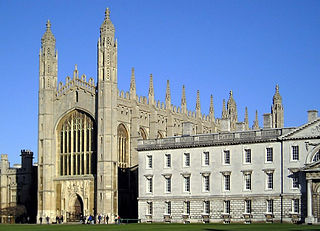
King's College Chapel is the chapel of King's College in the University of Cambridge. It is considered one of the finest examples of late Perpendicular Gothic English architecture and features the world's largest fan vault. The Chapel was built in phases by a succession of kings of England from 1446 to 1515, a period which spanned the Wars of the Roses and three subsequent decades. The Chapel's large stained glass windows were completed by 1531, and its early Renaissance rood screen was erected in 1532–36. The Chapel is an active house of worship, and home of the King's College Choir. It is a landmark and a commonly used symbol of the city of Cambridge.

Westminster Chapel is an evangelical free church in Westminster, central London. The church is in Buckingham Gate, on the corner of Castle Lane and opposite the junction with Petty France. Buckingham Gate is just off Victoria Street and near Buckingham Palace.

The Parish Church of St Margaret is a Church of England parish church situated on St Margaret's Road, off Bury Old Road (A665) in Prestwich, Greater Manchester, England. The Grade II listed church, in the Diocese of Manchester, was designed in the Decorated style by the Manchester architects Travis and Mangnall in 1849 as a chapel-of-ease to the ancient Prestwich Parish Church of St Mary the Virgin. Opened in 1851, it was extended in 1863, 1871, 1884, 1888 and 1899, and is notable for its fine Arts and Crafts wood carvings by Arthur Simpson of Kendal and late twentieth-century fittings. The church's daughter church of St George, Simister, is in the same parish.
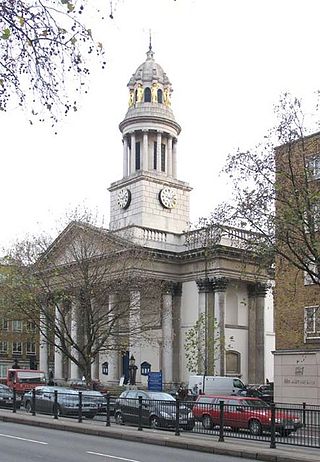
St Marylebone Parish Church is an Anglican church on the Marylebone Road in London. It was built to the designs of Thomas Hardwick in 1813–17. The present site is the third used by the parish for its church. The first was further south, near Oxford Street. The church there was demolished in 1400 and a new one erected further north. This was completely rebuilt in 1740–42, and converted into a chapel-of-ease when Hardwick's church was constructed. The Marylebone area takes its name from the church. Located behind the church is St Marylebone School, a Church of England school for girls.
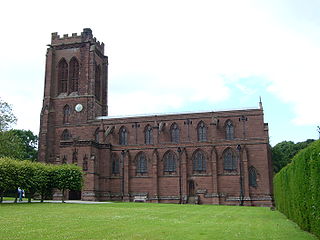
St Mary's Church is in the village of Eccleston, Cheshire, England, on the estate of the Duke of Westminster south of Chester. The church is recorded in the National Heritage List for England as a designated Grade I listed building. It is an active Anglican parish church in the diocese of Chester, the archdeaconry of Chester and the deanery of Chester. Its benefice is combined with that of St Mary, Pulford. The Dukes of Westminster are buried in the adjacent Old Churchyard.
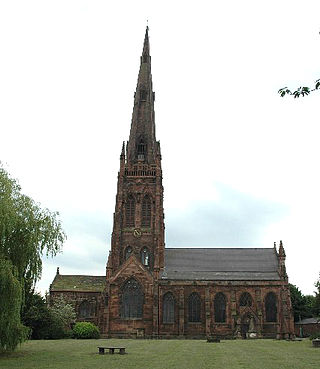
St Elphin's Church is the parish church of the town of Warrington, Cheshire, England. The church is recorded in the National Heritage List for England as a designated Grade II* listed building. It is an active Anglican parish church in the diocese of Liverpool, the archdeaconry of Warrington and the deanery of Warrington.
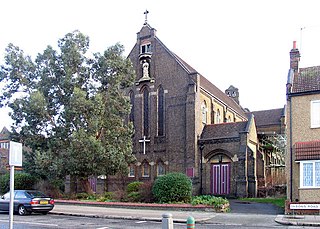
St. John the Evangelist, Upper Edmonton, is a church in Edmonton and is within the Diocese of London and are under the Bishop of Edmonton, formerly the Rt Revd Peter Wheatley. St John is within the Anglo-Catholic tradition of the Church of England and has the Mass at the centre of parish life.

The Church of the Annunciation, Marble Arch, is a Church of England parish church in the Marble Arch district of London, England. It is dedicated to the Annunciation to the Blessed Virgin Mary. It is a Gothic revival building designed by Sir Walter Tapper and built in 1912–1913. It is a Grade II* listed building.

St Nicholas's Church is a Grade I listed parish church in the Church of England in Tuxford, Nottinghamshire.
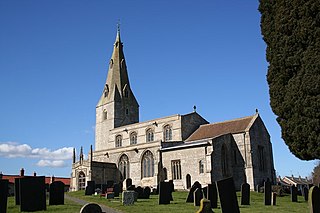
St Peter's Church is a Grade I listed Anglican parish church dedicated to Saint Peter, in Ropsley, Lincolnshire, England. The church is 5 miles (8 km) east from Grantham, and in the South Kesteven Lincolnshire Vales. St Peter's is in the ecclesiastical parish of Ropsley, and is part of the North Beltisloe Group of churches in the Deanery of Beltisloe, and the Diocese of Lincoln.

St Andrew's Brighton is the oldest continuous Anglican church in Victoria, Australia. St Andrew's is the Anglican parish church of the beachside suburb of Brighton, Melbourne.

Reverend Sir Frederic Shelley, 8th Baronet (1809–1869), of Shobrooke Park, Crediton, Devon, was a cleric and landowner.

Our Lady and the Apostles Church is a Roman Catholic parish church in the Edgeley area of Stockport, Greater Manchester, England. It was built from 1903 to 1905 and replaced St Philip and St James Church, built in 1803, which was the first permanent Catholic church to be built in Stockport after the English Reformation. It is situated on the corner of Shaw Heath and Greek Street, south west of Stockport College and south of Stockport railway station. It was built in the Gothic Revival style by the architect Edmund Kirby and is a Grade II listed building.

South Audley Street is a major shopping street in Mayfair, London. It runs north to south from the southwest corner of Grosvenor Square to Curzon Street.
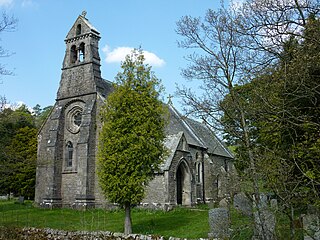
St Mary and St John's Church, Hardraw is a Grade II listed parish church in the Church of England in Hardraw, North Yorkshire.

St Giles' Church, Matlock is a Grade II* listed parish church in the Church of England in Matlock, Derbyshire.
St Mary the Virgin Church is a parish church in Welling in the London Borough of Bexley. It is dedicated to the Virgin Mary. The church is in the Archdeaconry of Lewisham & Greenwich, in the Diocese of Southwark. It is notable for the range of 20th-century art contained within it.
St Mary and All Saints Church is the parish church of Little Walsingham in the English county of Norfolk. It is dedicated to the Virgin Mary and All Saints. Little Walsingham was the location of the shrine of Our Lady of Walsingham, destroyed at the Dissolution. The Anglican shrine was revived by Alfred Hope Patten, the Vicar of Little Walsingham, in 1922, and the image of Our Lady of Walsingham was in the church until its translation to the new priory in 1931.

St Mary's Church is a parish church in Swanage, Dorset. It is dedicated to the Virgin Mary. The church is in the Archdeaconry of Dorset, in the Diocese of Salisbury. The tower is mediaeval; the church itself is a 19th and early 20th-century reconstruction. It is Grade II listed.























